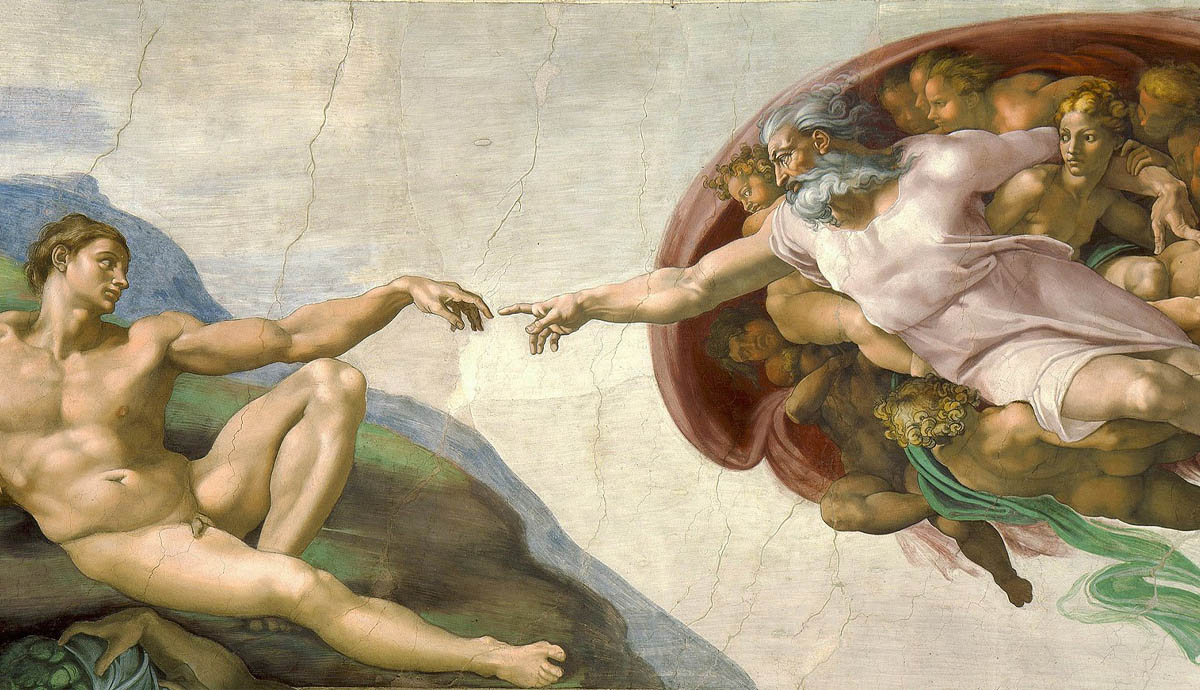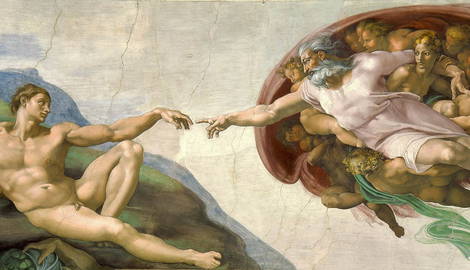
summary
- Michelangelo’s Creation of Adam was painted between 1508 and 1512 on the ceiling of the Sistine Chapel within the painter’s vast 500 m² Renaissance fresco masterpiece.
- God almost touching Adam’s finger signifies the divine spark of life and intellect granted to humanity.
- Drapery around God outlines a precise human brain, suggesting the gift of creativity and knowledge.
- God’s entourage resembles a womb and placenta, highlighting birth symbolism and women’s crucial role in creation.
Italian artist Michelangelo was one of the greatest artists of the Italian Renaissance and is still one of the world’s most famous artists. His greatest masterpiece was probably the interior of the Sistine Chapel, which he adorned with a stunning array of Biblical frescoes. It is an astonishing feat of artistic endeavor that took him over six years to complete, from 1508 to 1512. One of the most famous paintings in the Sistine Chapel is Michelangelo’s The Creation of Adam, which depicts God reaching out and touching Adam’s finger to give him the gift of life. It is a complex scene with many layers of symbolism, prompting many to ask what the deeper meaning is behind this breathtaking work of art.
Commission of the Sistine Chapel Ceiling

In 1505, the newly elected Pope Julius II invited Michelangelo to Rome. Initially, the Florentine artist received a commission to build the Pope’s tomb, with forty statues intended to be carved within five years. However, Michelangelo experienced constant interruptions as he was called on to complete other tasks, and the pope withdrew his funds. Thus, the project took 40 years and was never fully completed to Michelangelo’s satisfaction.
It was during these 40 years of work that Michelangelo painted the Sistine Chapel, with the artist convincing Julius II to let him take on this artistic challenge in an unfamiliar medium. The chapel, erected between 1473 and 1481 for Pope Sixtus IV (hence the name Sistine), had a special meaning for the papacy, and it was (and still is) for important ceremonies such as the election of a new pope. While its walls were decorated with a series of frescoes, the ceiling remained bare.

The Pope agreed, originally commissioning him to paint the Twelve Apostles on the triangular pendentives that supported the ceiling. He was simply to cover the central part of the ceiling with an ornament. However, Michelangelo persuaded Pope Julius II to grant him a free hand to complete a much more complex work, consisting of interconnected panels depicting episodes from the Bible, including the Creation, the Fall of Man, the Promise of Salvation, and the genealogy of Christ.
The final composition covers more than 500 square meters on the Sistine ceiling and features more than 300 figures. Among them, the scene representing the Creation of Adam is one of the most replicated religious paintings of all time.
The Creation of Adam Shows God Creating Human Life

The most direct meaning in Michelangelo’s Creation of Adam is to capture God’s creation of human life, as described in the Book of Genesis (1:26) in the Christian Bible: “Then God said, ‘Let us make man in our image, after our likeness. And let them have dominion over the fish of the sea and over the birds of the heavens and over the livestock and over all the earth and over every creeping thing that creeps on the earth’.”
Michelangelo chose to illustrate this moment with complete clarity, painting God reaching out from above and almost touching Adam’s index finger with his own to create the first great spark of life. On the left, Adam is depicted lying on the ground, while God, surrounded by angels, reaches toward the first man with intent and determination.
God is Giving Adam the Gift of Intellect

Many have looked into Michelangelo’s composition in more detail and found possible suggestions for further hidden meanings. One argument made convincingly by MD Frank Lynn Meshberger is that the shape of the drapery and angels surrounding God resembles the outline of a human brain—amazing, right?
Meshberger noted surprising correlations between Michelangelo’s design and the anatomy of a real brain, observing sulci in the inner and outer brain, the brain stem, the basilar artery, the pituitary gland, and the optic chiasm. This astonishing level of accuracy reveals Michelangelo’s profound understanding of human anatomy and his desire to imbue this into the meaning of his art.
Michelangelo Believes We Should Aim for Intellectual Pursuits

Even more astonishingly, Meshberger notes how God reaches out from the more emotional side of the brain (the right hemisphere), the area that deals with creativity and imagination.
As Adam is already alive and fully conscious in Michelangelo’s painting, Meshberger argues that it is not merely the gift of life that is being bestowed upon Adam in this moment, but something more—the gift of artistic and academic ability.
Michelangelo believed deeply that his artistic talent was a God-given gift that he had been destined to share, and in some ways, perhaps, he saw his own image in the body and mind of Adam here. Perhaps, too, he saw all of mankind and the incredible awakening of human ability that was occurring during the Renaissance, which led to such remarkable moments of breakthrough.
It is as if Michelangelo were instructing all people to strive for the highest level of achievement possible, because we have been given the divine gift of consciousness.
Michelangelo Painted Adam Being Born From a Womb

One more anatomical reference has also been made in relation to Michelangelo’s Creation of Adam, adding further possible layers of meaning to the painting.
A 2013 study suggests that the shape God and the angels create resembles that of a womb and placenta, suggesting Adam was given birth to, rather than being created by God in thin air. The authors of the study have even compared the circle of angels in the background to the surface of the placenta and the line that unites God’s outstretched arm with that of Adam to an umbilical cord.
This connection points towards a significant growing awareness of science and anatomical understanding during the Renaissance, though perhaps Michelangelo did not know to what extent they would come to eclipse Biblical ideologies.
Michelangelo Highlights the Importance of Women in Childbirth

Interestingly, it has been noted that God’s presence is far more dominant than Adam’s in Michelangelo’s scene, which is perhaps understandable since he is portrayed as the creator of all life and the entire universe here.
God’s arm also encircles that of a prominent female character, perhaps a mother counterpart to God’s father-like role. It is almost as if Michelangelo is telling us that he understands the importance of women in childbirth and creation. If this is true, it presents a fascinatingly complex argument for the equality of the sexes within the biblical story of creation and the vital role of women within it.
Michelangelo Included the Creation of Eve

At first glance, it may seem that there is no mention of Eve in Michelangelo’s fresco. However, in 2019, scientist Deivis de Campos noted that the left side of Adam’s torso contains an extra concealed rib. Michelangelo’s deep knowledge of human anatomy suggests that this was intentional and that it represents Eve.
Campos suggests that this extra rib inclusion was a way for Michelangelo to represent Adam and Eve being created side by side, which differs from the traditional Catholic Church teaching that Eve was created after Adam. There is significant evidence that Michelangelo radically disagreed with many Catholic traditions.
Michelangelo’s The Creation of Adam & Its Legacy

While the Creation of Adam is now one of the great jewels of Western Art, it was lost for many years due to the darkening caused by centuries of smoke that affected the ceiling. It was only after the Vatican Museums organized cleaning in the 1970s and 1980s that the true impact of the image was revealed, with many not believing that this vibrant image was originally painted by Michelangelo.
Today, it is impossible to think of the story of the creation of Adam in the Bible and not think of Michelangelo’s work. Moreover, even without the Biblical reference, Adam is a commanding form that has inspired many studies of the human body and the male nude.










